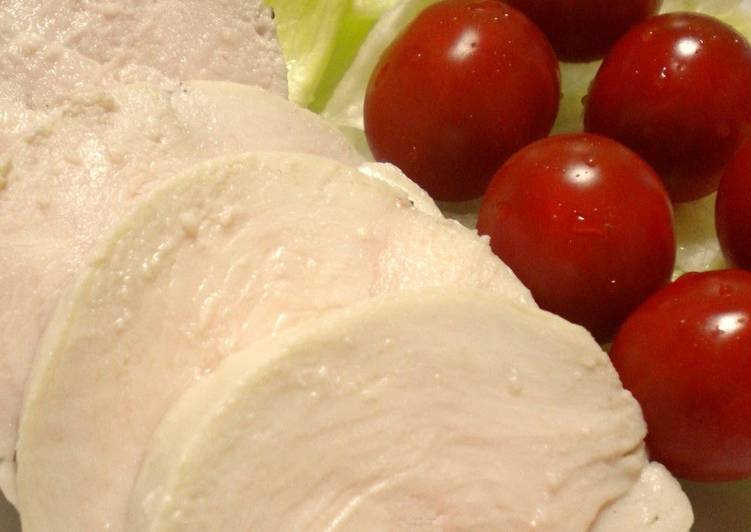The Ultimate? Tender and Moist Chicken Ham. Boneless, skinless chicken breasts (aka BSCBs) — is there anything more boring? They are all too often overcooked until dry and chewy, and Fortunately I have one method that makes unfailingly juicy and tender boneless, skinless chicken breasts. Need some chicken for a salad, or to top some pasta?
 Crispy Parmesan Garlic Chicken with Zucchini is a fantastic one pan meal that the family will love!
The chicken is so tender and breaded with an amazing parmesan garlic crust and.
I find chicken thigh tender and juicy enough to use without tenderising.
You can have The Ultimate? Tender and Moist Chicken Ham using 5 ingredients and 15 steps. Here is how you achieve that.
Crispy Parmesan Garlic Chicken with Zucchini is a fantastic one pan meal that the family will love!
The chicken is so tender and breaded with an amazing parmesan garlic crust and.
I find chicken thigh tender and juicy enough to use without tenderising.
You can have The Ultimate? Tender and Moist Chicken Ham using 5 ingredients and 15 steps. Here is how you achieve that.
Ingredients of The Ultimate? Tender and Moist Chicken Ham
- You need 2 of Chicken breast.
- It's 2 tbsp of Yogurt.
- Prepare 1 tbsp of Sugar.
- It's 1 tsp of Salt.
- Prepare 1 dash of Pepper.
What does Velveted Chicken taste like? Ever notice how the chicken in stir fries at your favourite Chinese restaurant is incredibly tender, and how it's just never as good at home? Chicken is very tender on its own, but it dries out quickly. We marinate chicken for flavor, not to reduce toughness.
The Ultimate? Tender and Moist Chicken Ham instructions
- Remove the skin from the chicken breasts..
- Place the yogurt, sugar, salt, pepper (as much as you like), and chicken breasts into a plastic bag. Close the bag tightly and leave to macerate in the refrigerator for 2~3 days..
- When the chicken has finished macerating, remove from the bag and wipe lightly with a paper towel (don't rinse it). It is okay to leave some of the yogurt mixture on the chicken..
- Group together the 2 chicken breasts and wrap them tightly (reference steps 11 and 12 for information on size). When you have finished wrapping, seal the ends of the wrap with rubber bands..
- Place the wrapped breasts into a sealable bag. Seal the bag firmly so that no liquid will get into it..
- Bring a good amount of water to a boil, and place the bag into it for 15 seconds. Turn off the heat and cover with a lid. Let this set as it is for 2 hours. (For more details see steps 13~15)..
- After 2 hours, remove the bag from the water, and chill in the refrigerator for 6 hours (do not remove from the bag). Now it's done..
- The finished chicken ham will be tender and moist. Because it is so tender, take care when slicing it..
- Savoury soup: By the way, the liquid in the plastic bag is the juice of the chicken and yogurt mixture. If you add this to soups, it will create a rich flavour..
- To store: The ham will keep for about a week in the refrigerator. Please use it quickly as it doesn't contain preservatives..
- Addendum to Step 4: Butterfly the raw chicken breasts and turn them so the thick and thin sides fit evenly together. This will help the chicken hold together evenly without gaps and make cutting easier..
- Addendum to Step 4 (continued): Wrapping two breasts does not necessarily glue them together. To allow for easy cutting, you can also make a small ham using just one breast..
- Addendum to Step 6: The cooking time in boiling water is not 15 minutes, but 15 SECONDS. Turn off the heat and the chicken will continue to cook through using the residual heat of the water. Protein is degraded by heat, so by heating slowly in a lower temperature, you are ensuring a moist result..
- Addendum to Step 6 (continued): Please prepare plenty of boiling water for the chicken (at least 2 litres). Bring the full quantity up to a boil before adding in the chicken. If the water is not hot enough it will cool too quickly and the chicken will not cook through..
- Addendum to Step 6 (continued): After sitting in the cooling water for 2 hours, it is okay to remove the chicken, even if the water is not thoroughly cool yet. There is no need to let it sit in tepid water for a longer period of time as this will not affect the chicken..
There are many ways to help retain If the recipe doesn't call for the chicken to be breaded, what I've found keeps the chicken moist is actually something I learned from the Marshall. Bones and skin help keep meat moist as it cooks. Chicken breast in particular cooks much better with skin because, as there's so little fat, it needs all the help it can get to retain moisture. If you don't like the taste of the skin (or want to lower the calorie count), peel it off once it's cooked. If you bake a ham and then throw away the bone, you've committed a war crime.